In all facets of education, learning activities are designed to cater for and appeal to a variety of learning styles (Click here to read the article "What is your learning style?"). In Fleming's VARK model, these styles are generalized into three main types: visual, auditory and kinaesthetic. English language schools in Australia are no exception and try to employ every type of activity to meet the needs of their precious students. Vocabulary cards which are moved by hand to match with definitions or used to play games such as memory or snap are aimed at kinaesthetic learners, for example. Text book audio files, songs, dictation, etc. are geared toward our auditory friends. However, in what ways can English as a second language (ESL) teachers appeal to their visual learners?

For those who are not blessed enough to work in a modern Australian Language School, where we shamelessly use plasma TVs hooked up to a high-powered ultra-modern computer, one of your few tools is the white board. This is your bread and butter as an English language course teacher and as such, it is advisable to invest time and money into making the most of it. Purchasing white board markers of various colours is a good start. Solely using a black will quickly earn you the disrespect of all of your students. If you write illegibly, go back to primary school and learn how to print in a straight line. It's an Intensive General English class, not a hieroglyphs deciphering session (Bec Hungerford). It is useful for students to have a well-organised whiteboard. Date and name your board with a brief outline of the day's lesson on one side. On the other side, leave room for a list of new vocabulary items. Underline your subtitles and use bullet points as you would in a Powerpoint presentation. Too many words and clutter will only further the confusion reeked by your black pen monotony.
Art. Vincent Van Gogh said before he tragically cut his own ear off, 'If you hear a voice within you say 'you cannot paint,' then by all means paint, and that voice will be silenced.' One of the most hilarious and memorable things you can do for your students is to attempt to draw. "Teacher, what are gills?" Draw a sideways egg, draw a comb facing the bottom of the egg to form a tail, two side-by-side baked beans at the 'top' of the egg to form fish lips and then you are in a prime position to add 2 backwards Cs to illustrate gills (see attached image). When drawing, it's important not to take yourself seriously. Laugh at yourself if your picture is absolute garbage. Your students will thank you.
There are countless other ways to appeal to visual learners. Having a well-organised, colourful board and hand-drawn illustrations are two of the most basic. In closing, practice makes perfect and Vincent Van Gogh was probably not an auditory learner.
Clinton Taylor